Shared Legacy Farms CSA Week 2 Newsletter, June 19, 2022
Farm Newsletter Week 2
June 19-25, 2022 | “B” Week
This is what broccoli rabe looks like.
What’s in the Box this Week?
BROCCOLI RABE (RAPINI) (1 BUNCH) ~ Also called rapini, broccoli rabe should be a deep, rich green all over, with tightly closed florets, firm stalks, and no yellow flowers or yellow spots. It has a mustard-like flavor and is used in Chinese cooking. (This vegetable is not actually related to broccoli! It is closely related to turnips which is why the leaves look like turnip greens.) Store unwashed in the fridge, wrapped in a plastic bag To prep: Cut off and discard 1 inch from stem ends. Cook in a 6- to 8-quart pot of boiling salted water until just tender, about 3 minutes, transferring with a slotted spoon to a large bowl of ice and cold water to stop cooking. To freeze: Wash thoroughly and cut off woody stems. Blanch (plunge into boiling water) for three minutes and chill quickly in ice cold water. Drain off excess moisture, package in airtight containers or freezer bags and freeze immediately.
Need some help with this new veggie? Download my free veggie e-book all about Broccoli Rabe with suggested recipes and best uses!
GARLIC SCAPES ~ The scape is the flowering part of the garlic plant that emerges in June. We cut the scape before it blooms to redirect energy back to growing the bulb. It has a milder garlic taste and can be substituted for garlic. Store scapes unwashed in a loosely wrapped plastic bag in the refrigerator for up to 2 weeks. To prep: Chop off the very tip and woody parts of the stem. Then mince finely and use in place of garlic. To use: Garlic scapes can be chopped or diced raw into green or pasta salads, sautéed in place of bulb garlic, sprinkled onto pizza, eaten raw, or used anywhere garlic flavor is desired. They’re also great grilled. To freeze: Scapes can be chopped and flash frozen in Ziplock bags.
GREEN HEAD LETTUCE (1) ~ Store unwashed lettuce in a Debbie Meyer Green bag or Tupperware FridgeSmart container in the refrigerator. To store lettuce that you have already washed and dried with a spinner, place back in a plastic bag with a dry paper towel in the bag, and place the package in the vegetable crisper bin. Use within 4 days. To prep: Slice the head at its base with a knife and let the leaves fall open. Discard any damaged or leathery outer leaves and tear large leaves into bite-size pieces. Wash leaves in a basin of cold water. Dry in a salad spinner. To freeze: Not recommended.
CARROTS (with tops) ~ SAVE THE CARROT TOPS! You can make really cool stuff with them… To store, first take the tops off your carrots and put them into a plastic bag in the fridge. The roots should be stored separately in the crisper in a plastic bag. If they get soft, just put them in some water tocrisp them up again. Eat within 3 weeks.
Don’t throw the carrot greens away! Use them to make carrot top pesto! Or dehydrate them on your counter and add them as a parsley-type herb to future dishes. Or throw them into a “veggie scrap bag” in your freezer (with other things like the tops of celery, onion skins, carrot ends). When the bag gets full, use it to create your own DIY veggie broth (which you can then freeze into ice cubes for later use!) Not sure how to make DIY broth?… grab our guide here.
DILL WEED ~ Store upright in a container with an inch of water. Then cover the herbs loosely with a plastic bag and refrigerate for up to 2 weeks To prep: Chop the leaves and stem before cooking. To cook: Dill is a standard in pickling. It also combines well with green beans, broccoli, cabbage, carrots, cauliflower, tomatoes, parsnips, potatoes, spinach, cucumber, squash, eggplant, and eggs. To freeze: Trim off the long stem ends leaving only an inch attached to the feathery foliage. Place a couple of sprigs together inside a resealable plastic freezer bag; press out all of the air and seal. When you need fresh dill for a recipe, remove the frozen sprig and snip off what you need while still frozen. Do not let it thaw.
PURPLE SCALLIONS ~ Place your scallions into a glass filled with an inch of cold water and place it in your fridge (or leave on the counter). I like to place a baggie over the tops of the greens, if it’s going in my fridge to keep them from drying out. Refresh the water every 3 days. These will last a long time stored this way. You can trim the green tops off the scallion and use them to garnish tacos or salads or meat dishes. You can also chop them up and freeze them for later use! The purple tips of the onions are often used in salad dressing vinaigrettes, on salads, or enjoyed grilled with a little olive oil and s/p.
RED RADISHES (WITH GREENS) ~ Remove leaves if they are still attached. Store the unwashed greens in a loosely wrapped Debbie Meyer plastic green bag in the crisper bin of your refrigerator and eat them ASAP. (Add them to scrambled eggs or try making our CSA’s popular frozen “Green Cubes” and add them to stews/sauces for later). Store the radish roots dry and unwashed in a plastic bag in the refrigerator for 1 week. I like to roast these with other root vegetables in some olive oil at 400 F until soft! They’re also good on the veggie tray with some dip. And if you haven’t tried pickled radishes, they will blow your mind.
POTTED HERB PLANT ~ You will be given a choice at pickup of several herb types. When you take it home, put it in a sunny place in your garden or on your kitchen windowsill. Then be sure to “prune” the plant as it grows. This means cutting the herb leaves along the stem. This will cause the plant to branch off where you pruned it, and get bushier over time. It’s important to stimulate growth by pruning!
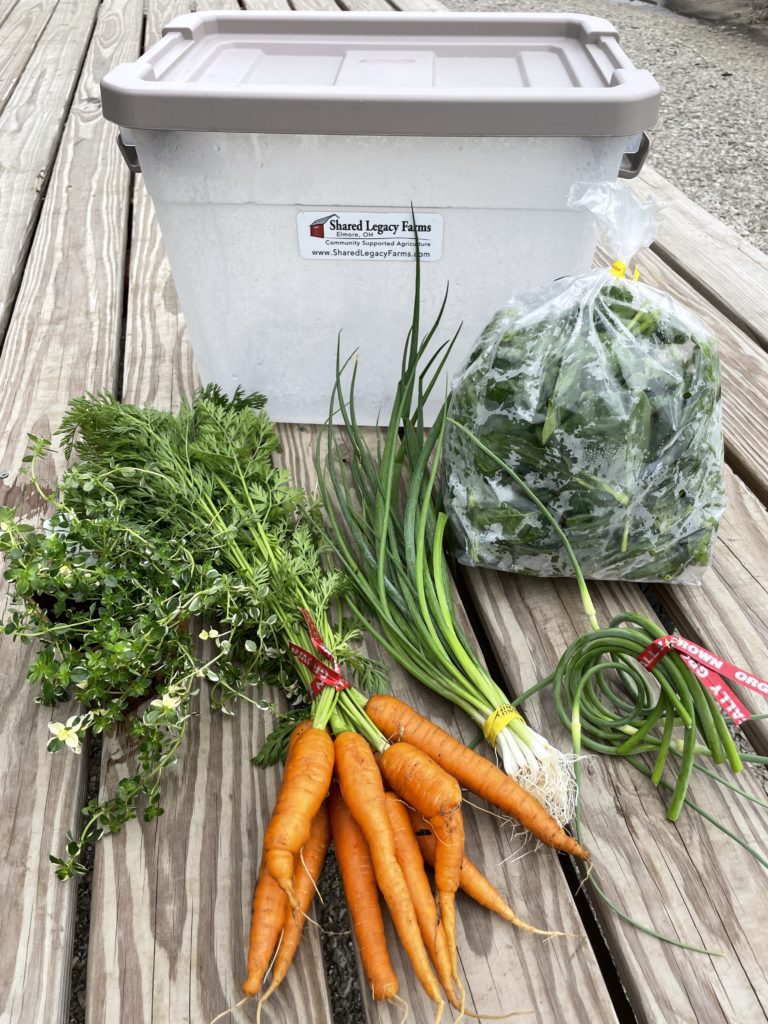
Last week’s box photo.
WEEK #1 ADD-ON SHARES: We are Week “B”
Odd-numbered weeks of our CSA season (week 1,3,5) are called “A” weeks. And even-numbered weeks (week 2,4,6) are called “B” weeks. If you have any kind of non-veggie, bi-weekly share, you have been assigned to either “A” or “B” week for the season. If you get a cheese share, it always comes on Week “A.”
WEEK 2 FRUIT SHARE:
STRAWBERRIES (1 QUART) ~ (from Polter’s Berry Farm, Fremont) To store: Put your berries in a colander in your fridge (or store them in a Debbie Meyer Green Bag), where they will keep for up to 5 days. Do not wash until you eat them. To prep: Wash off the berries and remove the green tops before eating. To freeze: Place whole berries on a cookie sheet and freeze. Once they are frozen, pop them into a Ziplock bag for easy storage and freeze.
SWEET CHERRIES ~ (from Quarry Hill Orchard, Berlin Heights) Sweet cherries will be either a dark red color, or a red/yellow blush color (the Rainier cherry) and are best for eating out of hand. Sour cherries are usually a bit soft, and are best used in baking pies or cobblers. Store cherries in your refrigerator in a plastic, perforated bag in the crisper drawer for up to a week. To prep: Remove stem. Pit the cherries after washing. To freeze: Choose firm, ripe cherries. Pit cherries first (although you don’t have to). Flash freeze on a sheet pan. Then pop into a Ziplock bag. Freeze for up to a year.
RHUBARB (1 bunch) ~ (from Wayward Seed Farm, Fremont) This tart vegetable is one of the first to emerge in the spring. Because of its sour taste, sugar is usually added. It has the look and texture of celery and can be red or green. To store: Wrap in plastic baggie and place in the fridge. Use within a week. To prep: Remove the leaves and bottom inch of the stalk. Chop or mince. To use: Add to pies, cakes, muffins, scones, jello, or just try making an easy sauce to top your ice cream or pound cake. Try eating rhubarb raw as a snack, dipped in sugar! To freeze: Super easy! Just chop and pack into Ziplock freezer bags to flash freeze. I often do this with my rhubarb, because I’m at a loss for how to use so much of it. It lasts for up to a year this way!
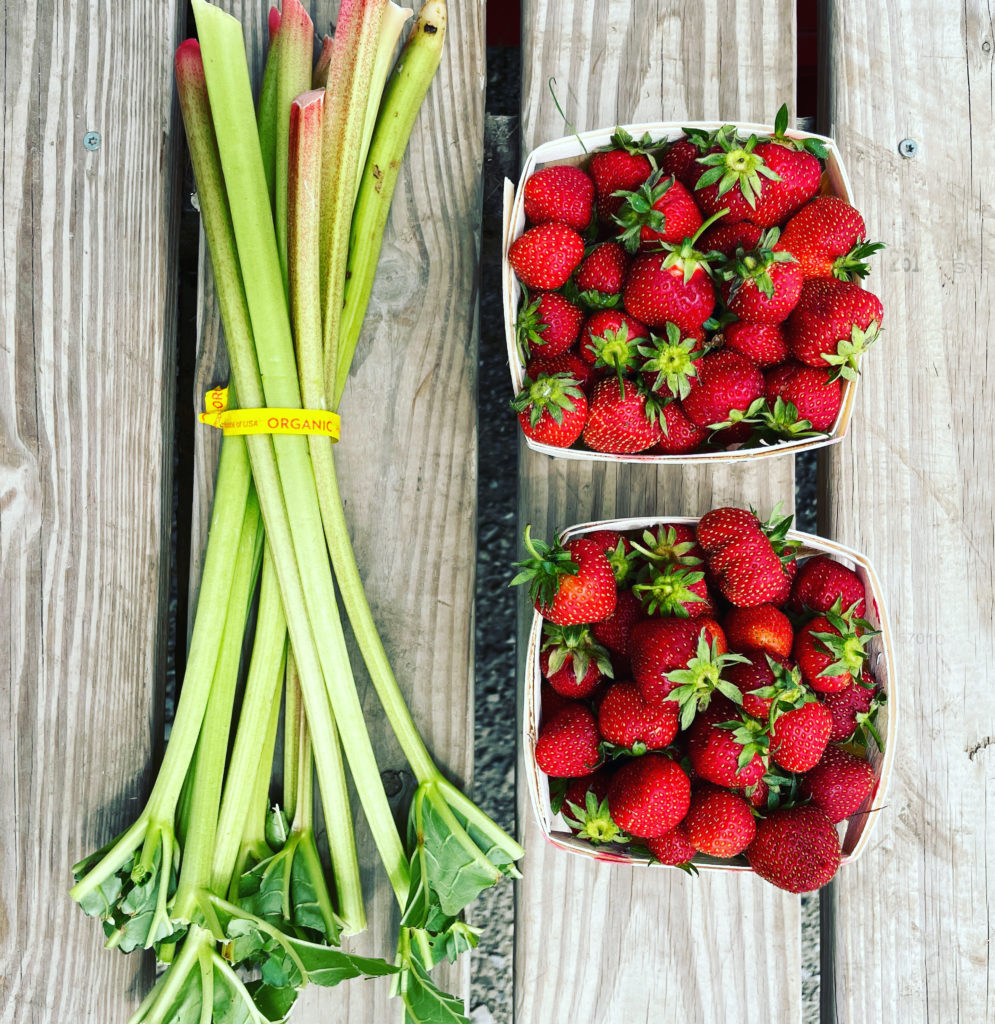
The week one fruit share
Ice Cream Flavor of the Week:
Strawberry from Knueven Creamery. Note: be sure to stop and pick up your ice cream from the Knueven milk truck at your pickup site! They will be located either right before or after your veggie pickup. Your farmers will not be passing this out in their delivery line.
COFFEE Flavor of the Week:
Maddie & Bella Coffee Company ~ Mexico High Grown Altura ~ crisp, full, sweet
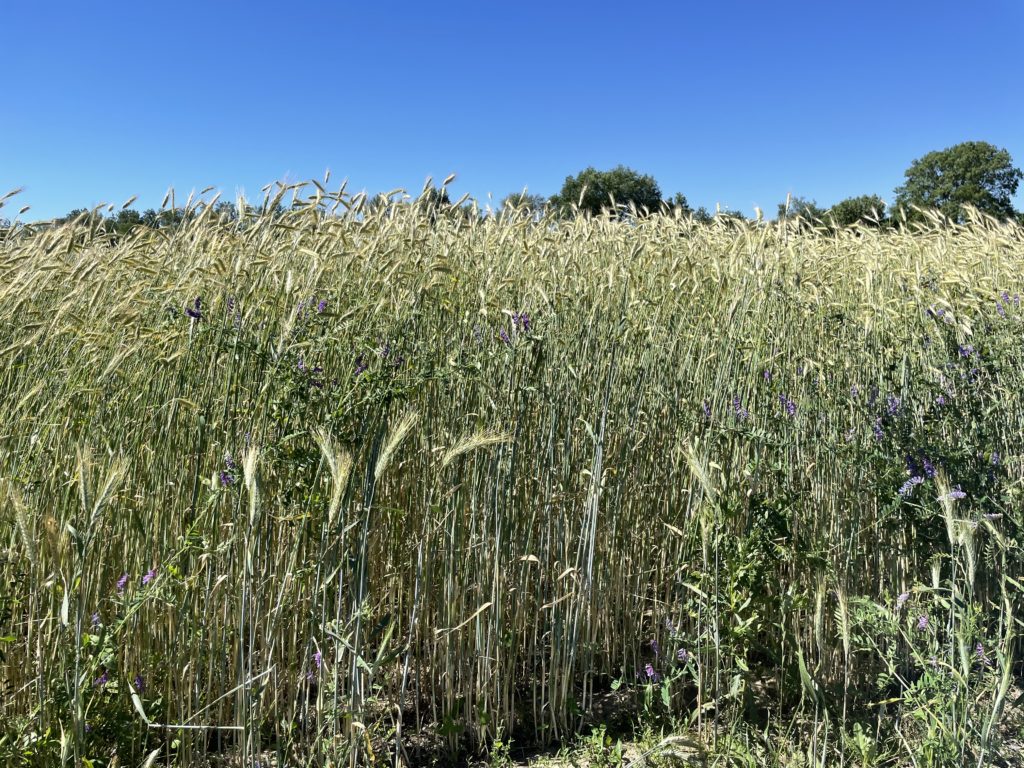
Rye is a cover crop that builds soil health! We’ll cut the rye heads down and save the seed. The leftover will be used to make straw bales. And the remaining roots and stubble add value to the soil.
Letting the Soil Rest
You’ve probably heard how important it is to let your soil “rest” periodically. In the farming world, this is called “lying fallow” or “fallow ground.” It is possible to burn out your soil if you just keep trying to plant something into it over and over again.
Soil is alive. And it needs to be treated as a living organism. We feed it and let it rest, so it can replenish all those vital nutrients and micro-biology that makes things grow and taste so good. Those vegetables that you get from us each week are nutritious because they are taking those powerful nutrients from the soil. If we don’t have a process that allows the soil to replenish and heal, our soil will eventually stop growing things for us, become more prone to disease, and literally diminish in volume as it’s “used up.” (Soil is disappearing on our planet at an alarming rate.) Your vegetables would also taste more blah and be less nutrition-dense.
When we first started our farm in 2008, we just burned through soil like an amateur. We used every inch we had every year. When a bed emptied out, we turned it over and replanted right back into it. We started to notice lower yields after 2 years. Doing soil tests confirmed that our soil was very low in organic matter, and certain key trace elements were lacking. All that overwork had drained the soil of energy.
This is what began Kurt’s foray into the world of organic soil health. How could we turn our focus to stewarding the soil instead of taking as much as we could from it for personal profit and gain?

Mowing down a cover crop allows the organic matter to break down and build soil value.
Kurt began planting cover crops over winter. These are crops that are planted in order to put energy, nutrients, and organic matter back into the soil — kind of like feeding the soil. Having a crop like Sudan grass or field peas will cause all kinds of micro-biology to start churning below the soil — even in the off-season — keeping the soil busy and alive.
He began “resting” larger and larger sections of soil blocks for the whole season. This was difficult to manage in our early years, because we had a quota of veggies to meet for our CSA, and technically we didn’t have enough land to do things right by the soil. We did the best we could in the interim, adding cow manure from our neighbor and cattle rancher Josh. We started raising chickens and moving the chicken house through the fallow fields to dump nitrogen-rich droppings on our fields. Kurt began buying in compost and applying it to our tired soil beds.
But we committed to a long-range plan to get more soil into the rotation, so that we give our soils a healthy rhythm of rest and work. This involved renting additional acreage from our parents next door in 2019. We began converting it into organic production — a process that technically takes 3 years for certifiers. Three years we did nothing but plant cover crops on this soil! This past season, it became officially certified, opening up all kinds of freedom for us.
We now manage roughly 40 acres of ground out at Shared Legacy Farms. And of that, 65% is now lying fallow every year. Think about that for a second. Over half of our ground is resting. The rest is growing vegetables for you.
We make sure to “rotate” the crops through these fields as well. Crops don’t ever get planted in the same place for 6 years! That’s a lot of extra work to manage the production plan and planting map, but when you have more land to work with, you have more options to fit it all in right. There is a sequence we follow:
Year 1: cover crop
Year 2: Solanacea
Year 3: fall roots and cole crops
Year 4: cover crop
Year 5: spring roots, cole crops, alliums
Year 6: cucurbits
Soil health is important to us. And it should be to you, too. We believe that soil is one of the Earth’s greatest natural resources. Large, wider rotations are absolutely key to keeping our farms viable in the long-run.

Meet the winning signs of our Car Sign Contest!
Winners of the CAR SIGN CONTEST
We saw lots of SLFarms Team Spirit last week at our pickup sites! Our thanks for bringing the energy to our first week. Here are the winners of our Car Sign Contest. Congratulations! Each winner will receive their choice of a pint of Knueven Ice Cream at their pickup site!
Sylvania: Jamie Squibb
Elmore: Jenifer Fox
Perrysburg: Eileen Sullivan
Port Clinton: Nike Mendenhall
Honorable Mention: Kate Lynn Zemba
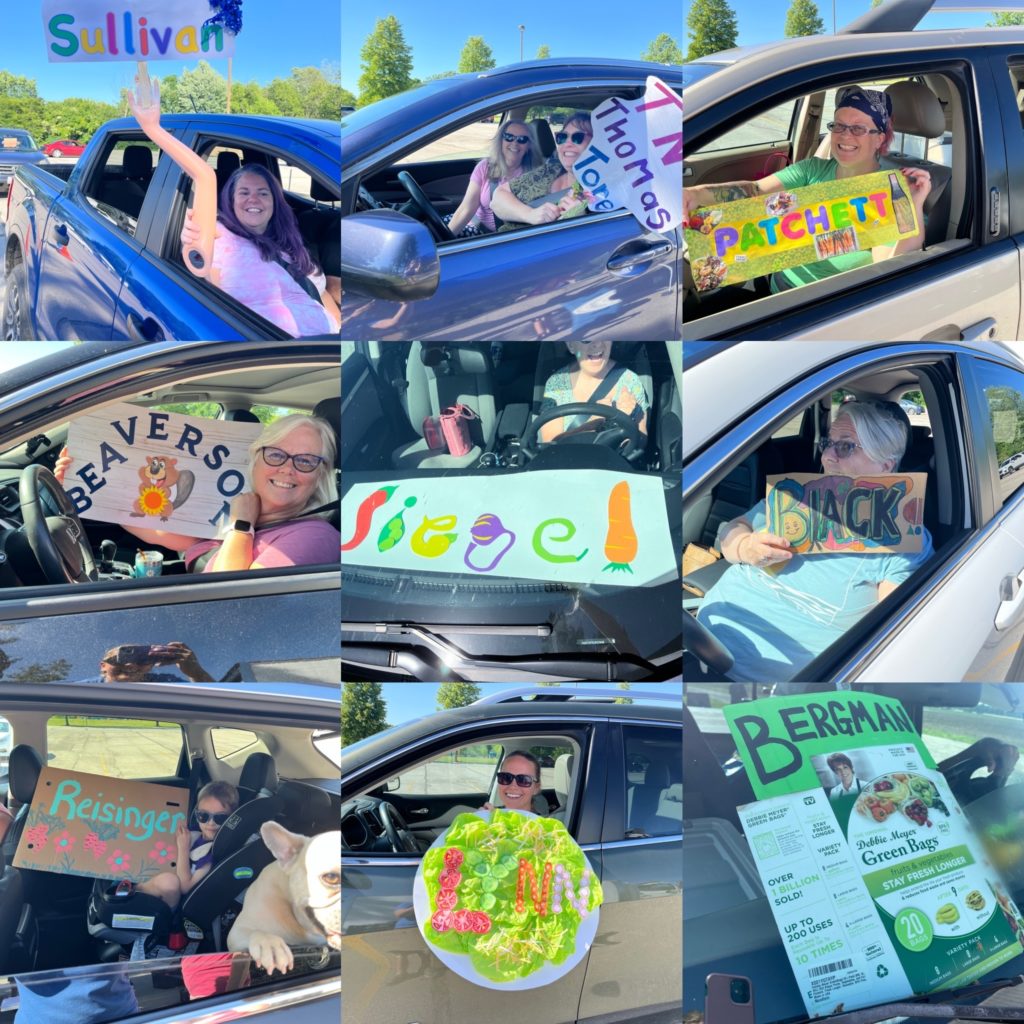
So many good entries this year!
FARMER KURT’S FIELD NOTES
We made it through week 1! A big thank you to my wife, Corinna, for pulling off an administrative miracle, organizing so many pieces of the machine. It was GREAT seeing you all again. And your car signs were great! We had a hard time picking our favorites. (Best in show at each site gets a free pint of ice cream).
This past Monday night, we had a pretty big thunderstorm hit Elmore, and it took down our power for about 8 hours. This happened around 9:30 PM after we had just finished packing the boxes for Sylvania and Elmore. The first thing I thought about was how I had 3 walk-in coolers of CSA vegetables, strawberries and cheese (and two personal freezers of meat and frozen product) that needed to stay cold ASAP. And of course, the cord that connected to my generator was at my parent’s house! So I rushed down to Curtice in the middle of the night, and grabbed the cord. I set up one generator to power the house, and the second tractor-generator to run the farm’s coolers. Keep in mind, I’m doing this in the pouring rain — trying to catch breaks in the downpour to hook up electricity. I caught cat naps on my rolling cart in the Pack Shed, as I waited for the rain to abate. And then crawled into my Hino truck to keep an eye on the greenhouse — just in case it tried to blow away in the crazy wind.
It was a long night. Corinna made me sleep all day Tuesday.
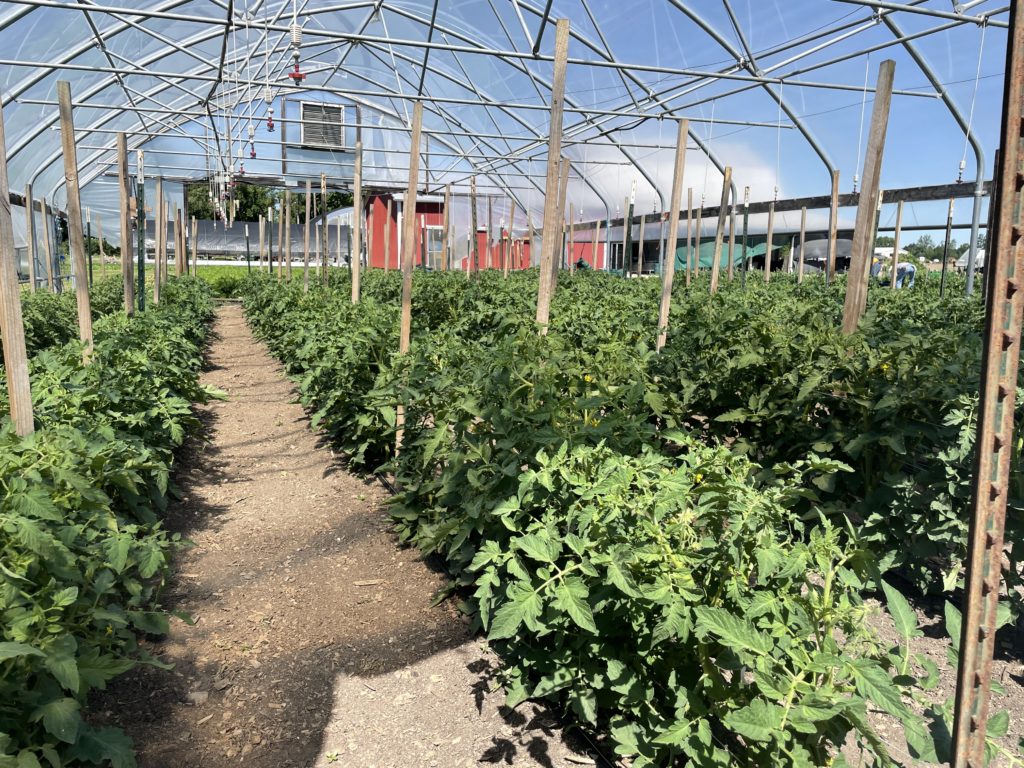
I started these tomatoes early in a high tunnel. Look how big they are!
We got about 2.5 inches of rain Monday night. That’s a lot of water in one day. Our plants came out all right though. I was worried my tomatoes would get beat up. Luckily I had done some organic spraying the night before. This is a preventive kelp extract that helps with water and heat stress. And we had weeded the succession crop of field carrots the day before. Some of my farmer friends nearby were not so lucky — they reported hail damage.
I’ve got a rabbit problem out here this season — I see them nibbling on my lettuce and greens. The woodchucks are so bad that they’re destroying the edges of the soybean fields of my neighbors. You can walk down the bike path and physically see the damage. Harley, our farm dog, is only interested in chasing chickens, and has turned into an inside dog somehow. I had hoped she would help control the population, but right now my cat is doing more for that than my dog.
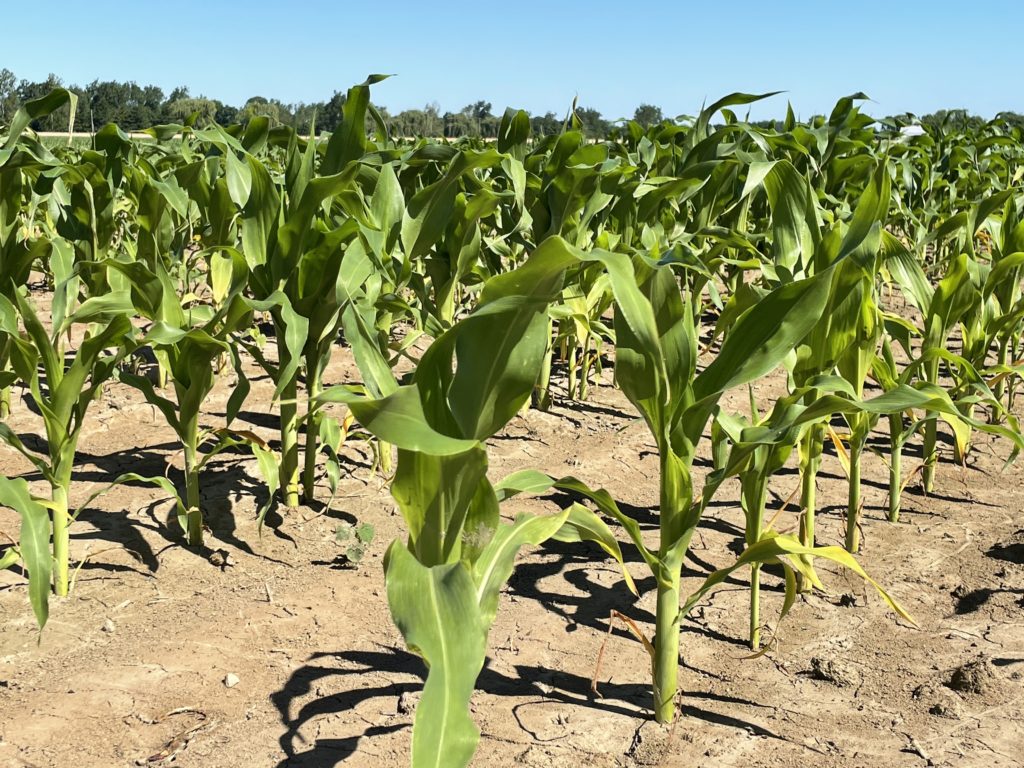
Sweet corn is loving the heat. This is the first planting, which should be ready around July 20.
Our big job this week was staking the tomato beds. You can watch a video of it below. With so many crew members this year, we made short work of this. I got over 2 beds of tomatoes staked in about 4 hours — a personal record. This is a pretty hefty upper-body workout. We use a heavy metal stake pounder that fits over the wooden stake and is pounded in by hand with 3-5 strokes. Other crew members are walking around placing the stakes at regular intervals — making things a whole lot faster. All in all, we place around 1300 stakes. We had ideal weather for it, too. Because the ground was still soft from the rains, the stakes easily pounded right in. And the cooler, breezy weather kept us from overheating.
We also put the first of the tomato twine on our tomatoes. I hadn’t planned on getting to this, because I thought staking would take so much longer. But when I saw how fast my crew was moving on Friday, I jumped into the car to go pick up some more tomato twine boxes from Amish country, so we could make short work of it on Saturday morning.
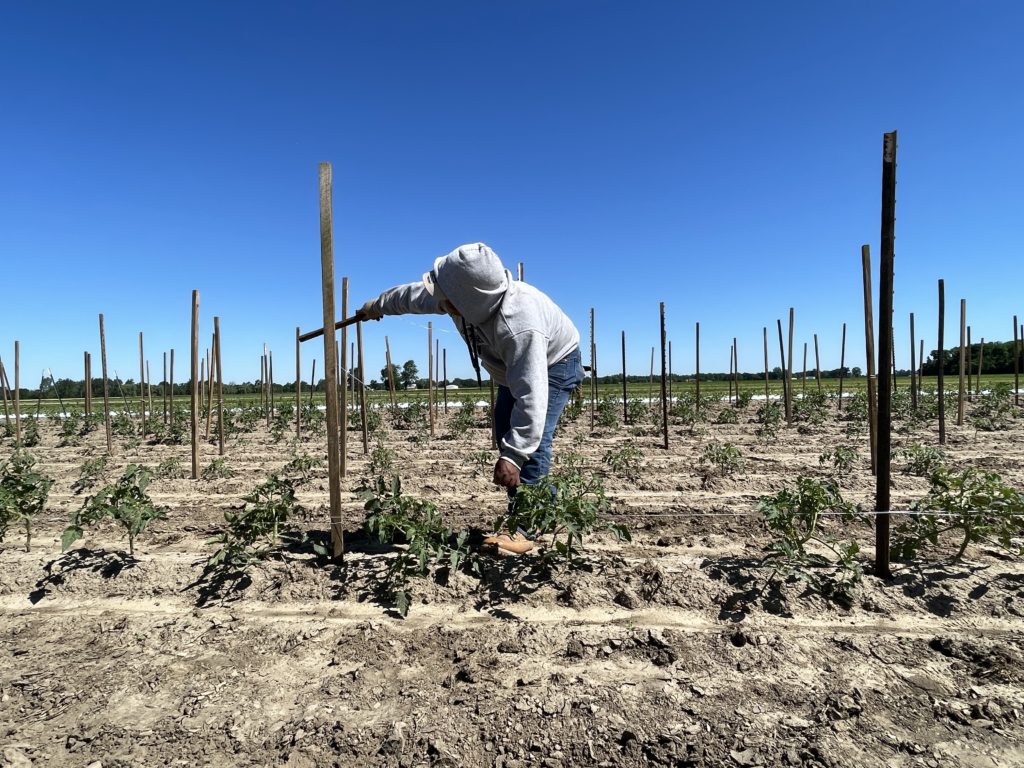
Jesus ties the tomatoes using a box of twine and a stick.
I’ll be planting the third planting of sweet corn this coming week. We’re on track to have our first sweet corn by June 20th. The melons look great. I’ve got a high tunnel of early tomatoes, which should be ready by mid-July, if the heat keeps up. Noah and John propagated broccoli, cabbage and cauliflower for the fall in the greenhouse this week. We are keeping up with the production plan.

A new pole barn is going up this week to hold all our equipment currently sitting outside.
This weekend, a new pole barn is going up next door on my dad’s place. The steel frame went up in one day. This barn is mostly to house all my farm equipment which has been sitting out in the open air. Corinna went around last week taking pictures of all the implements I have sitting around for an Instagram Reel — it’s pretty ridiculous.
I’ve got a lot of weeding to do this weekend. All that rain brought out the weed seed. In years past, it was hard to stay on top of the cultivation – -partly because I had too many other jobs to be done on the farm (and not enough crew members) AND because I didn’t have the right mechanical equipment to help me. This weekend, I was able to hop on the tractor and quickly cultivate my beds, knowing that my crew was working on the tomato twining. Here’s a quick video showing the before and after effects of mechanical cultivation.
It was HOT this week. We were able to get away on Wednesday to go to White Star Quarry and swim. One of our goals this year has been to create free time during the week to relax and do fun things with the kids. Thanks to our phenomenal team, I’m feeling so much less stressed this year. It was surreal to be playing in the water from 1-3 PM on a CSA Harvest Day. I’ve never had that happen before. We took Pedro, Polo, Jesus, and Jose along too. (They thought it was pretty cold!)
~Your Farmer, Kurt

Leave us a google review of the box this week! You’ll find a card like this in your box.
WEEK 2 ANNOUNCEMENTS
- Don’t forget to bring back your plastic veggie tote back on week 2. We’ll sub it out with a fresh one. Simply leave it in your car wherever you want the next bin to be placed by our team. Please return all egg cartons. We can re-use them.
- Leave us a Google Review! This week you’ll find a card in your veggie box that asks you to leave us a Google review of your CSA box. We’ll send these out periodically this season. One of our goals is to increase the number of reviews on our Google site. This helps us find new clients by making our farm show up first on the Search results page of Google! So how do you leave the review… Easy peezy! Hover your camera app over the QR code on the postcard. A window will pop open to leave your comments. Write a review — a few sentences is great — or leave us 5 stars, and hit submit! It’s pretty easy!
- Watch our weekly Live Unboxing video this Tuesday around 8 PM inside the private Facebook group. Cadie Jardin, our CSA coach and dietitian, will show you what’s in the box, share storage tips and ideas for how to use your product. You can find the Facebook group at this link. If you aren’t on Facebook, we download the unboxing video into the digital Academy library (which you all get free access to). Reach out to me if you can’t figure out how to get into the Academy. (www.sharedlegacyfarms.com/academy) — note: you should NOT pay for a membership to the Academy. You get in for free with your membership!
- This week, I’ll be scheduling volunteers for the first 8 weeks of the season. If you’d like to help out one time during a CSA Pack night (Mondays and Wednesdays from 4-8 PM), please email me.
- You can order additional items from the Shared Legacy Farms online store. Our store link is super easy to remember: www.sharedlegacyfarms.com/store. Just be sure to select the right pickup site that coincides with your pickup location. If the pickup option is greyed out or not available, it means you missed the window to order. You need to place your order 36 hours before your site. We harvest the product on Monday and Wednesday mornings — early. This week, the store will have: white scallions, garlic scapes (bunches of 6), snap peas (only 30 — our first early harvest), green curly kale, carrots, red radishes, green head lettuce, broccoli raab, dill bunches, and parsley, along with local maple syrup, rye flour, and extra eggs from Jed/Josiah.
 Order Your Wild Alaskan Salmon Now
Order Your Wild Alaskan Salmon Now
from Citizen Salmon Alaska
Our Community Supported Fishery partner begins fishing for wild Alaskan salmon after June 15th. Aaron is trying to get an idea of how many folks will be wanting fresh wild salmon, so he can schedule his small-crew fishermen. Place your order for salmon, halibut, or scallops now at www.CitizenSalmonAlaska.com. You can order ANY time of year while supplies last.
The fish is SUPER fresh — processed and blast-frozen within 5 hours of the catch. Aaron processes it into smaller cuts (individual portion sizes) and each portion is vacuum-sealed. It arrives frozen on your doorstep, or your money back. And you’ll get a notification from Aaron once it’s shipped so you can keep track of its progress.
As a CSA member you get a 5% discount on ALL online orders with CitizenSalmonAlaska.com through December, 2022. Use the coupon code we gave you in your email. Note that the price of overnight FedEx shipping is included in the cost you see per pound on the website. You get a significant savings the more fish you buy. So a 50 lb. order of salmon will be much less than a 15 pound order. CSA members are organizing group orders right now inside the CSA Facebook group. So if you only want 20 lbs, you can partner up with other folks to get to the 50 lb. level and get the big discount.
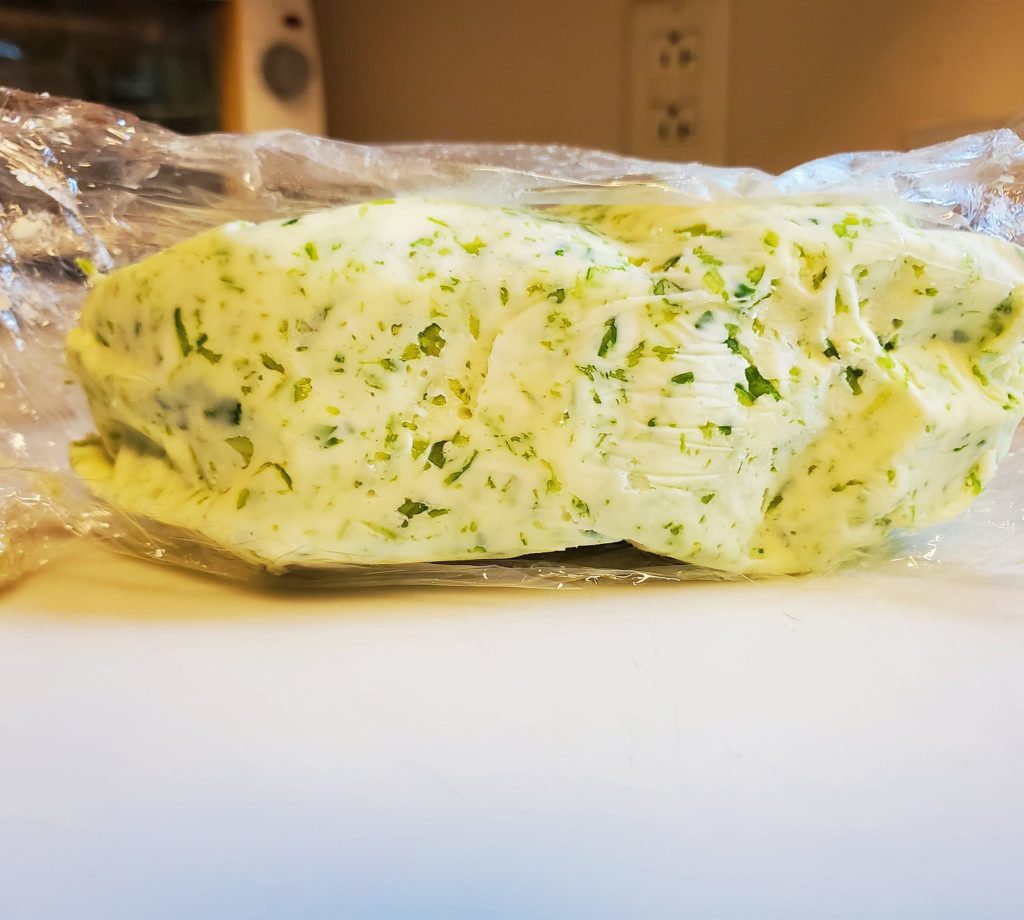
Danielle Kuhl shared this photo of compound butter she made with last week’s garlic scapes.
WEEK 2 CSA RECIPES
Members: You can download these recipes as a PDF here. These recipes are designed to inspire you to use your box this week! Please check inside our private Facebook group to find your fellow members sharing ideas for what to make with their box! Share a photo and you might be featured in next week’s newsletter!
Veggie Cream Cheese
Simple Roasted Carrots & Radishes
Roasted Radishes with Brown Butter, Lemon and Radish Tops
Garlic Scape Compound Butter
Creamy Dill Sauce
Sauteed Broccoli Rabe
Baked Pasta with Sausage and Broccoli Rabe
Broccoli Rabe, Potato and Cheddar Frittata
Seared Scallions with Poached Eggs
Pickled Scallions
Roasted Carrots with Dill
Grilled Pork Tenderloin with Cherries
Cherry Vanilla Dark Chocolate Overnight Oats
Raspberry Rhubarb Margarita

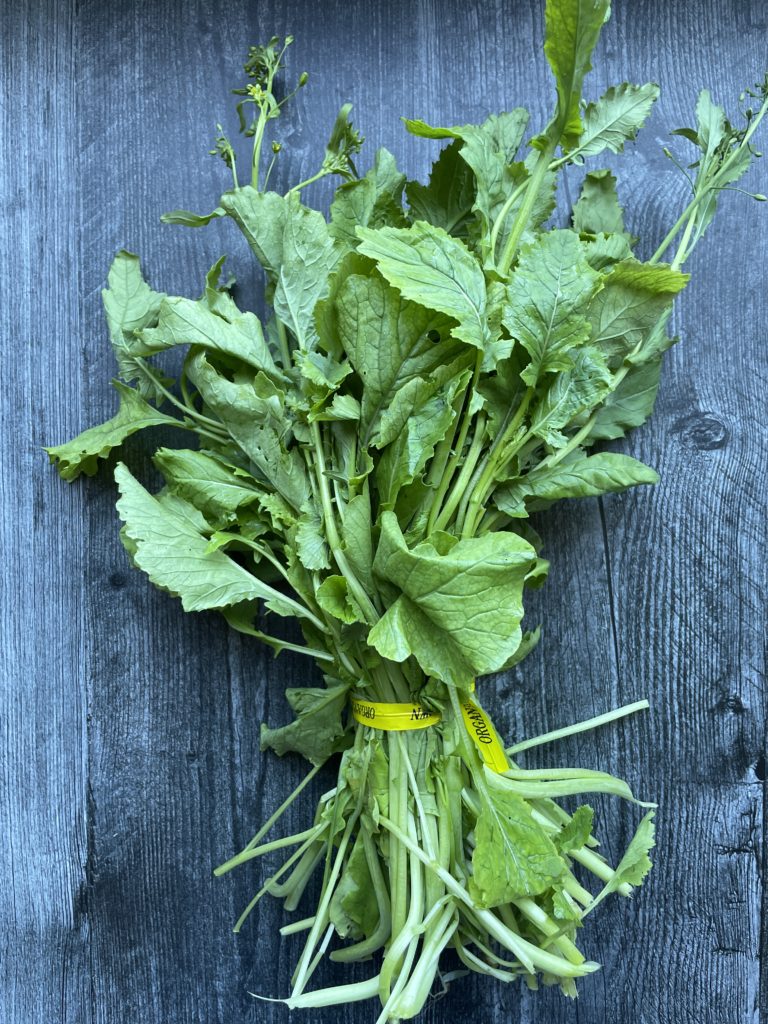
 Order Your Wild Alaskan Salmon Now
Order Your Wild Alaskan Salmon Now